No, This Isn't WW3. Not If You Believe the Gold Market
Why isn't the gold price at $5,000 per ounce...?
"WE'RE in World War 8 if you believe the market."
So said Jim Sinclair, then a commodities broker...now a long-time internet guru on precious metals...to the New York Times back in January 1980, recounts Adrian Ash at BullionVault, writing to readers of the Weekly Update last Monday.
That month saw gold prices hit $850 per ounce. It would remain the peak for almost 3 decades.
Gold had jumped 30% in a week...
...trebling in price from 6 months before...
...as the double-digit inflation of the 1970s' peaked with the Soviet invasion of Afghanistan and the US embassy hostage crisis in Tehran.
Gold prices didn't beat that New Year 1980 peak until the global financial crisis of 2008. The metal then set a fresh record high at $2075 during the Covid Crisis of 2020.
But four decades of inflation...albeit gentler than back then, at least until New Year 2022...now mean that $2000 ain't worth what it was. Nor is $850.
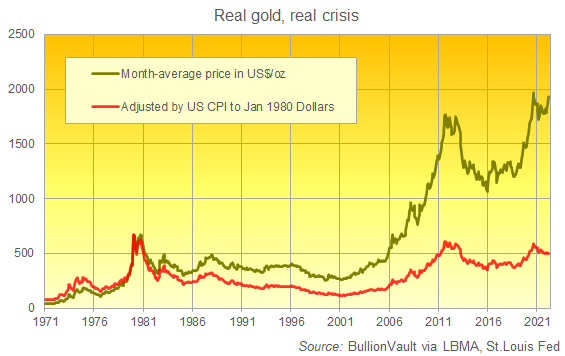
Upshot? Gold could have further to run yet.
Much further.
On a month-average basis, in fact, it would need to rise 36% from March 2022's current level to match that Jan 1980 high.
But even then, would that kind of jump reflect the true horror taking hold today?
"Apart from a nuclear holocaust," writes a long-time BullionVault user...
...sharing his thoughts and questions via our usual email address...
..."I can't imagine a more shocking state of affairs than a double whammy of a global pandemic...followed by a megalomaniac with 4,500 nuclear warheads in his arsenal [invading a European nation] with the risk he might press the button.
"So why isn't gold running at $2500 per ounce? What would have to happen for gold to double in price...never mind reach $10,000, which [some] gold pundits say it may reach in a crisis?"
To be clear, this isn't about greed, let alone profiteering from the terror in Ukraine.
It's just a simple and natural ambition of wanting to balance risk on other assets, most of all stock-market shares, to try protecting the savings and standard of living for yourself and your family.
War and disease can't be hedged against. But their impact on your money might be different.
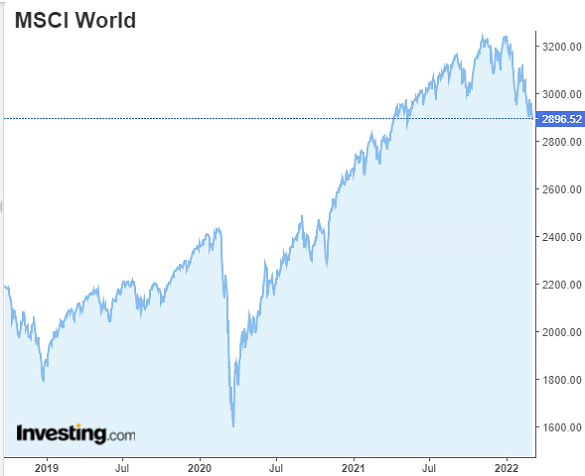
"I have had physical gold now for over 10 years," our customer's email explains.
"During that time it has gone up a little and down a lot. I have no yield on it and I have followed all the received wisdom that gold is good insurance. I tell my wife it's to keep our portfolio safe.
"But now we have open hostilities in Ukraine, the whole stock market under stress, unprecedented financial repression to discipline Russia...raging inflation [but] so much debt they are avoiding increasing interest rates too much...yet STILL gold doesn't jump like [some] pundits predict?
"Is gold 'done' as the asset of last resort? Why do I bother holding it?"
Fair points. And the bottom line is, we don't have an answer. Nor should we.
BullionVault isn't a financial advisor, and we genuinely can't know or say what course of action may be best at any time, neither in general nor more specifically for your personal circumstances.
That said, we do of course have opinions, research and analysis. And so to reply, let's start with the opposite question.
Why has gold risen as much as it has?
After all, and even after erasing this week's spike to $2065, gold is now 12% higher since the start of February in US Dollar terms...back when Vla! Vla! Vlad Putin! started spooking financial markets somewhat less than he spooked Ukraine with troops and rocket launchers massed along his neighbour's northern, eastern and southern borders.
Over the last 5 short, frantic and increasingly dreadful weeks, gold is also 14% higher in Sterling and 15% higher in Euros after a run of fresh all-time highs.
Global stock markets, in contrast, have gone the other way, as the chart above shows...
...losing 5% and more on the MSCI World Index.
Here again however, you might expect the impact to have been greater. Equity markets actually seem pretty calm overall given what's happening...
...well, outside Russia at least (where the Moscow Stock Exchange remains shut) and its near neighbours (Poland's WIG index has lost 20% from November's peak).
More globally, the MSCI World Index has now dropped only a little over 10% from the new record high it set on the first trading day of 2022.
That means developed-world stock markets have lost much less so far than they did during the Covid Crisis plunge of Feb-March 2020...
...and they have, as a group, fallen "only" to 10-month lows, rather than hitting 4-year lows like during that Covid Crash, never mind the multi-year lows hit during the global financial crisis or DotCom Crash.
Why so calm? No idea. But the fact is that financial analysts, traders and investors have pretty much all been caught off guard by Russia's attack.
For instance (and no relation)...
This isn't unusual.
European bankers and investors were famously slow in summer 1914 to take fright at the sabre-rattling between Britain, Germany, Russia and everyone else ahead of World War 1.
No one believed it could happen. Even as it did.
Back in today's gold markets, the rise in prices has met with very strong selling among physical owners.
These near-record prices in Chinese Yuan, for instance, mean "Gold investors have come in to my shop to sell" the Global Times quotes one Beijing-based retailer, now being handed kilobars of gold by profit-taking customers.
Plenty of other gold dealers across China...the world's No.1 gold consumer market, remember...have also been "witnessing a boom in investors selling their gold products" the Global Times goes on.
Here at BullionVault, a similar picture. New demand has jumped...and the number of new first-time users is now accelerating faster than any time since the Covid Crisis first hit.
But the absolute of new precious metals investors isn't so dramatic so far, lagging both the Covid Crisis and, on a daily basis, the record spike of the #silversqueeze phenomenon in early 2021.
Meantime, selling among existing users has jumped very sharply, outweighing the jump in demand and leading client holdings overall to shrink by more than 1/3rd of a tonne in February, equal to 0.8% of the 47 tonnes owned between them.
Among gold-backed ETF investment trusts, the trend has been a little firmer, but only a little.
Data compiled by the mining industry's World Gold Council says February saw the sector expand by just 1.0%...
...and with global jewellery demand of course sinking in the face of gold prices rising near (or above) record highs, there will be a lot of physical supply building up at dealers and bullion banks everywhere, working to offset the impact on prices of that new investment demand.
So who then is actually driving the price higher overall?
Step forward the usual suspects.
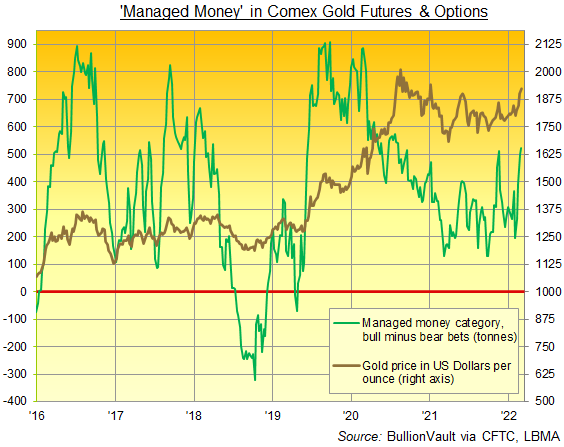
The derivatives market is where hot-money hedge funds are speculating that gold will shoot higher...
...while mining bosses, refiners and commercial dealers take the other side of those bets, protecting the value of their (increasingly large) physical reserves and stockpiles with bearish contracts.
Leading the cheerleaders, the 'Managed Money' category of Comex gold futures and options traders have now doubled their bullish betting...net of that group's own bearish bets...since the start of February.
That's quite the move. Converted into tonnage terms (an entirely notional idea, because these guys never want physical metal) it has outweighed the growth in global gold ETF tonnes almost 10 times over since the start of February.
What's more, this surge in bullish betting on gold has taken the Managed Money's net long position above last November's spike...up to the largest size since gold prices set their (current) all-time highs above $2000 per ounce back in summer 2020.
Yet here again, the size of the move isn't what it could be.
Managed Money traders grew their net bullish betting almost twice as fast over the 5 weeks ending 25 June 2019 as they have since the start of this February.
Back then, it was economic and financial trouble...as signalled by a steep drop in longer-term interest rates in the bond market...which urged the bulls to get super-bullish so fast.
The threat of all-out nuclear war seems less worrying.
Finally, why isn't gold surging even higher than it has given crude oil jumping towards its 2008 peaks at $150 per barrel?
Here again, the apparent 'lag' in gold might feel weird, if not frustrating.
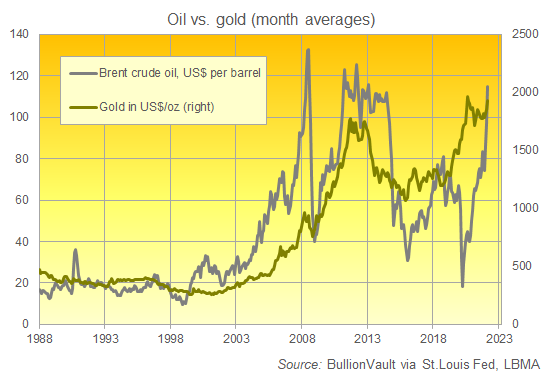
Priced in crude oil, gold bullion hit new all-time historic records back when commodities collapsed during the first wave of Covid shutdowns in spring 2020.
It's plain to see that gold at summer 2020's peaks above $2000 was then very richly priced in comparison to natural resources, something we noted on GoldNews at the time.
On average across 2020 in fact, one ounce of gold bought 46 barrels of oil. So far in 2022 it's been worth less than half as much...
...a mere 19 barrels on our maths today.
But that actually sits right at the historic average for gold priced in oil (18 barrels per ounce since the mid-1980s). This suggests that whatever "war-war" premium the markets are pricing today, it's much bigger in energy than it is in gold.
That doesn't mean the 'safe haven' of gold won't go higher, whether in cash or commodity terms. But the real sound and fury spurred by Russia's violence against its democratic European neighbour is currently hitting the energy markets more than bullion.
Again, that may seem complacent. It might suggest a world where shipping or flying consumer goods across the oceans will be free to continue...with the occasional block on Russian activity acting only to push fuel prices higher. All-out war between Nato and Moscow doesn't appear to be the energy risk which traders are betting on.
So, in sum, why isn't gold running at $2500 per ounce?
Most simply, it's because no one right now would pay it...and the only real price can only be what a buyer and seller agree.
That's why trading volumes in the wholesale market were thin on the Thursday spike when the Russian invasion began. Barely 1-in-6 of that day's 30 million ounces traded through London and Zurich's wholesale bullion markets were dealt above $1950 per ounce.
Second, therefore, the physical market is growing accustomed to the higher prices being driven by Comex speculation.
But those higher prices are also why net selling continues on BullionVault now that gold quoted in Euros has set fresh all-time records, why India's domestic gold prices have gone to deep discounts below London, and why some Chinese households are selling gold too.
What would have to happen for the selling to slow enough while new demand rose enought to see gold double in price?
My best guess...and it is a guess, offered for exactly the value you pay to read this free content...would be a long, grinding bear market in the stock market.
That's what doubled gold prices again and again in the misery and Cold War fears of the 1970s, and then again and again during first the DotCom Crash of 2000-2003 and then the global financial crisis of 2007-2012.
What proportion of your money you'd want to have in gold as a bear market hits stocks would of course depend on your confidence in gold actually performing. Which isn't guaranteed, even if that pattern has repeated time and again in modern times.
As for $10,000 gold, frankly I don't want to know what that world looks like.
That doesn't mean I'm not going to find out. But a jump to that level looks a long way off just yet.
We simply aren't in World War 3 yet. Not if you believe the markets.

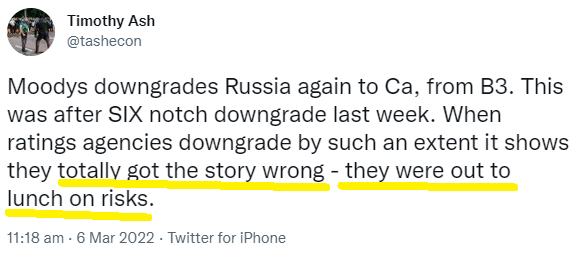








 Email us
Email us